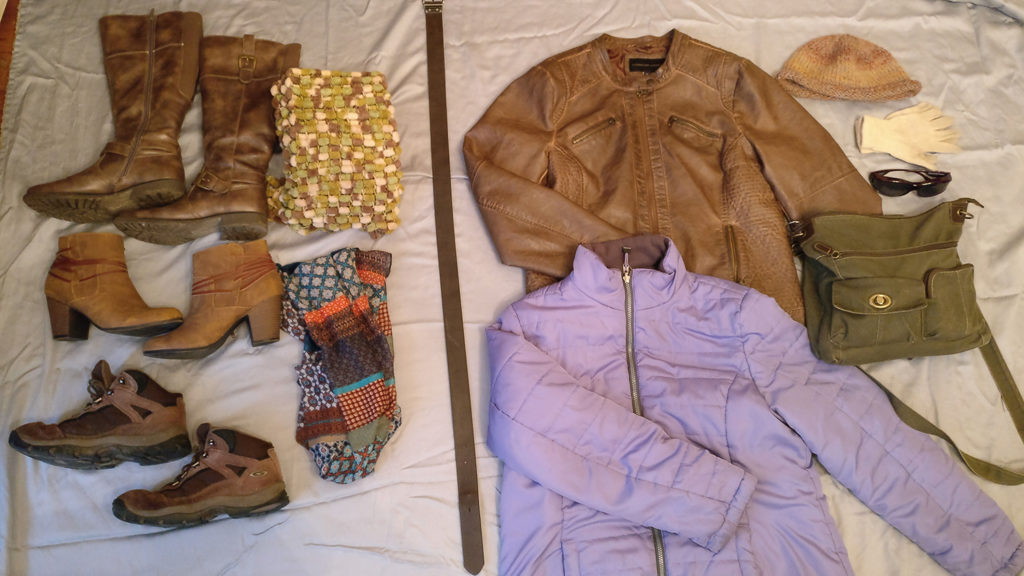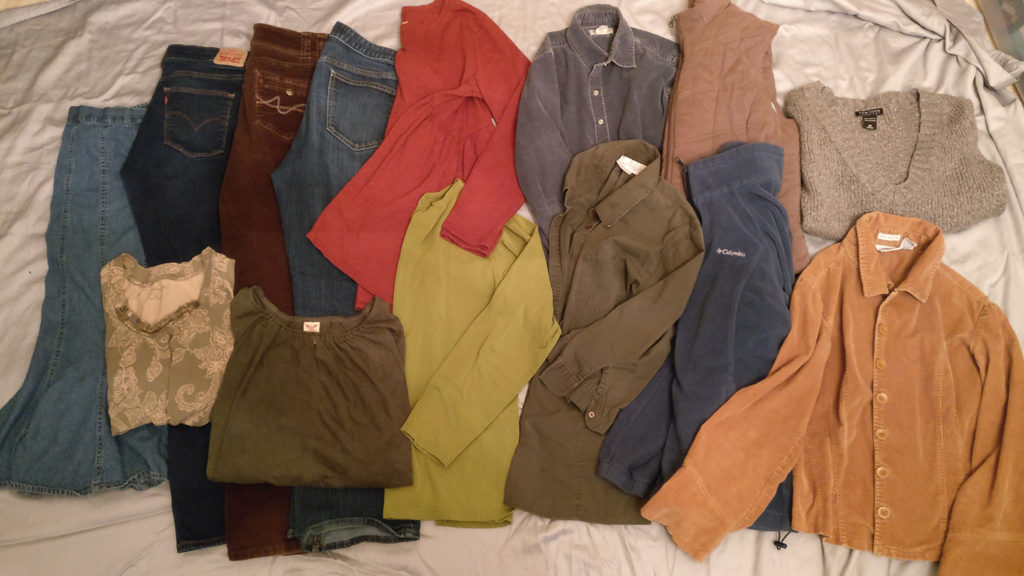Simple Sustainability – Minimalism: A year later – Part 1
by Sky Trombly –Over the course of 2017, I focused my sustainability efforts on minimalism. When I started out, I had no idea how great an impact it would make on my possessions, on my mental and emotional health, and on my life’s goals.
Minimalism and Dress
I’m currently wearing some of my favorite clothes. I feel comfortable, beautiful, and very “me” in them. It didn’t take me long today to choose something I really liked because my closet only contains clothes and accessories that I treasure. This is a far cry from where I began. I had mountains of clothes and nothing to wear. Many were ill-fitting or ill-suited to my body, style, and the messages I wanted to convey to others about who I am.
I always felt as though I needed something else and was never satisfied with the amount of clothes I had. Now, I have far (far!) fewer items, but everything has been chosen to fit together and to fill a role. I feel content. This means I will be consuming fewer clothes and that the one’s I do buy in the future will be thoughtfully chosen.
This may seem really superficial, but I’ve found a lot of gains beyond looking good (or, better). I’ve learned how flexible satisfaction can be and I learned to listen to myself for cues about personal style. I was never a follower of trends, but I still feel freer for giving myself permission to let them go. I also save time in selecting clothes – just about everything can be paired with anything else!
If you’re looking to get started with a more curated wardrobe, I highly recommend looking up “Project 333” which was my starting point. I love capsule wardrobes so much I do them for my three children
My winter capsule (see images) includes the following:

− 3 pairs of shoes (1 pair riding boots,
1 pair nice heeled boots, 1 pair hiking boots)
− 1 purse
− 2 coats (1 warm winter coat, 1 faux-leather jacket)
− 2 scarves (1 warm winter, 1 fashion scarf – patterned)
− 1 pair of gloves
− 1 knit winter cap
− 1 pair of sunglasses
− 1 belt (reversible – black and brown)
− 3 pairs of pants (1 skinny jean,
1 boyfriend jean, 1 brown corduroy)
− 1 nice jean skirt
− 2 long-sleeved t-shirts (green, burnt orange)
− 2 button down shirts (navy corduroy, green)
− 2 blouses (green paisley and faux-suede)
− 1 puffer vest
− 1 v-neck sweater
− 1 corduroy blazer
− 1 fleece sweater
= 26 items (does not include Pjs, workout gear, jewelry, or under-garments).
Minimalism and Time Management
Since becoming a minimalist, I’ve changed my relationship to time. Minimalism has helped me to understand that each of us only has 24 hours in a day. I realized thatsome of my beliefs and behaviors weren’t serving me. I used to behave as though I were immortal. I figured that I could eventually get to “doing it all”. I learned to let go of this idea and to focus on fewer things.
I learned that I had to be more present to be more productive. I needed to stop paying homage to a past self (by doing or having things that I used to feel were meaningful but no longer really care about) or hoarding for a future self that may never come. I needed to stop creating tasks for myself just to be a better (insert label).
Having fewer things means less time wasted in cleaning and organizing. Buying fewer things means less time spent earning money to pay for them.
As I embrace the concepts of minimalism, I’ve become clearer about what my priorities are. Knowing my priorities, I take special care to spend time each day and each week with them as the focus of my time and energy.
I’ve even found a means to structure time on days when I don’t have a set schedule. I break my repetitive tasks into four categories: “parenting”, “housework”, “writing and homework”, and “personal”. Then I cycle them on 15 minute or ½ hour basis (set to a timer) so that in an hour or two I have addressed them all. This works especially well for things like feeding and changing babies.
Minimalism and My Sustainability Efforts
I collected environmental tasks like some women collect shoes. The tasks grew so numerous that maybe I went a little crazy. And, sometimes, consistency went out the window due to my being overwhelmed. I never thought that minimalism could help me with my environmentalism. As I’ve written before, minimalism seemed to be just about throwing stuff away – often adding to landfills.
I feel very differently about it now.
I use minimalism at the top of my hierarchy of decisions for environmental thinking. As Bea Johnson, author of Zero Waste Home, would do: I first refuse what I do not need and then I reduce what I do need.
Minimalism has obviously had a drastic effect on my consumption habits. I buy fewer items and I first consider whether I could do without or do with less. I look for multi-purpose and/or durable items. Consuming less limits a lot of considerations. I no longer have to worry about the waste or the company’s ethics when I decide that something does not serve a purpose in my life. I just don’t buy it. In paring down, and in buying used whenever possible, I can afford to put money toward perhaps pricier items from companies that do care.
I’ve streamlined my lifestyle which saves me time and energy which I put toward things I know I value (as opposed to tasks that just ate my time). For example, I spend more time learning how to live eco-friendly and sharing what I’ve learned about sustainable living with others.
Minimalism and Books
One area that I still desperately need to minimize is my book collection and my attitudes and behaviors surrounding reading. I have 7 bookshelves in this room alone. A large proportion of them I have not even read. They sit here like a silent task list. Some of them tell tales of the hobbies I meant to get into or the skills I meant to learn. The fact is, their presence does not make me smarter or more capable.
I believe that by adopting the following behaviors, I will free myself. But only by being consistent with this for a while will I know if this approach will work:
− read 1 hour a day;
− read just one book at a time (textbooks, reference books, and workbooks don’t count);
− only keep books that warrant re-reading or referencing;
− donate, sell, or gift the rest;
− do not buy a new book until I have decided what to do with the last one I bought;
− borrow novels from library / buy digitally;
− limit my personal collection to the large bookshelf.
I am not done with minimalism by any means. This will be an ongoing process of self-reflection. While 2018 will mark a new sustainability focus in my work, I still have so many areas that need minimizing in my life.